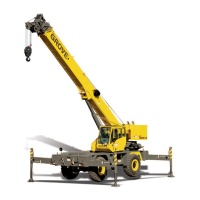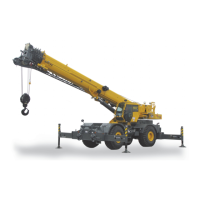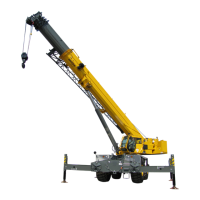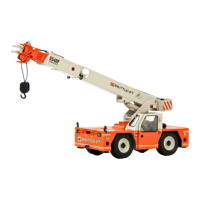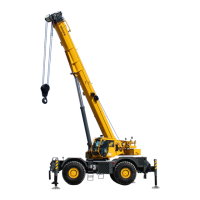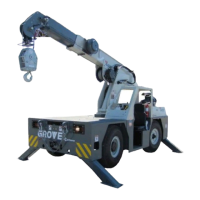HYDRAULIC SYSTEM RT540E SERVICE MANUAL
2-64 Published 4-20-2015, Control # 502-01
AXLE OSCILLATION LOCKOUT CYLINDER
Description
The two oscillation lockout cylinders (Figure 2-36) standard
or (Figure 2-37) CE Option, each have 12.7 cm (5 inch)
diameter bores. The retracted length of each cylinder is 48.8
cm (19.25 inches) from the center of the lug holes to the
center of the barrel bushing. The extended length of each
cylinder from the center of the lug holes to the center of the
barrel bushing is 65.5 cm (25.8 inches). Its stroke is 16.8 cm
(6.62 inches). A wiper ring prevents foreign material from
entering each cylinder. O-rings and other seals prevent
internal and external leakage.
The cylinder weighs approximately 38.8 kg (85.5 lb).
Maintenance
Disassembly
NOTE: Any maintenance requiring disassembly of the
cylinder should include replacement of all cylinder
seals.
1. Clean away all dirt from the head. Place protective
padding around the rod near the head to prevent
damaging the chrome. Using a spanner wrench,
unscrew the head from the barrel.
2. Open both ports on the side of the cylinder barrel and
drain the oil from the cylinder.
3. Secure cylinder barrel in a chain vise without putting
pressure on the side feeder tube preferably in the
vertical position with the rod assembly up.
4. Using a screwdriver, or 1/4 inch wrench, remove the
screw from the head.
5. Remove the grease fitting from the rod
6. Turn the head counterclockwise with a fitted spanner
wrench until the threads disengage.
NOTE: Residual oil will spill over the end of the barrel
when the rod assembly is extended. Make
provisions to contain the oil.
7. Using a hoist, extend the rod assembly slowly until the
piston is free of the barrel.
8. Remove the rod and attached parts from the barrel.
NOTE: Cover the barrel opening to avoid contamination.
9. Remove the lip seals and wear ring from the outside of
the piston.
NOTE: Arranging discarded seals and rings in the order of
disassembly will aid in installation of new seals and
rings. Pay attention to how each seal and ring is
installed to avoid installing replacement seals and
rings improperly.
10. Remove the retaining ring from the rod.
11. Remove the head from the rod. Remove the O-ring and
backup ring from the outside of the head. Remove the
wear ring, buffer seal, lip seal and wiper ring from the
inside of the head.
Inspection
1. Inspect the rod. There should be no scratches or pits
deep enough to catch the fingernail. Pits that go to the
base metal are unacceptable. Chrome should be
present over the entire surface of the rod. If lack of
chrome on rod, the rod should be replaced.
2. Inspect rod for straightness. Determine if it can be
straightened or must be replaced.
3. Inspect the head. Visually inspect the inside bore for
scratching or polishing. Deep scratches are
unacceptable. Polishing indicates uneven loading, and
the bore should be checked for out-of-roundness.
4. Inspect the piston. Visually inspect the outside surface
for scratches or polishing. Deep scratches are
unacceptable. Polishing indicates uneven loading, and
the diameter should be checked for out-of roundness.
5. Inspect the barrel carefully for scoring. If barrel is
scored, it must be repaired or replaced.
6. Thoroughly rinse parts, allow to drain, and wipe with a
lint-free rag. Inspect all parts for serviceability.
DANGER
Do not use air pressure to remove the rod. Use only a
source of controlled hydraulic oil pressure if the rod is
hard to remove.
CAUTION
Exercise extreme care when handling or setting down the
rod. Do not damage the chrome surface.
CAUTION
When removing seals and rings, avoid scratching the
grooved and gland surfaces.
CAUTION
Before installing new seals and rings, clean all surfaces
and carefully remove burrs and nicks. Parts displaying
excessive wear or damage should be replaced.
Reference Only

